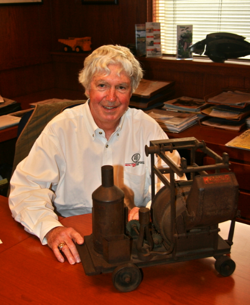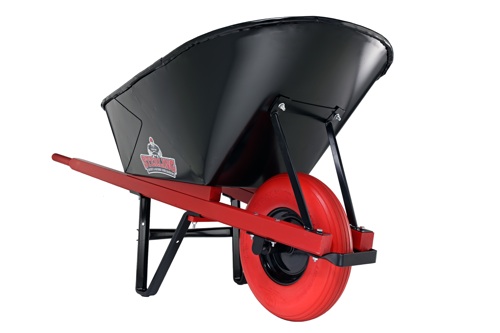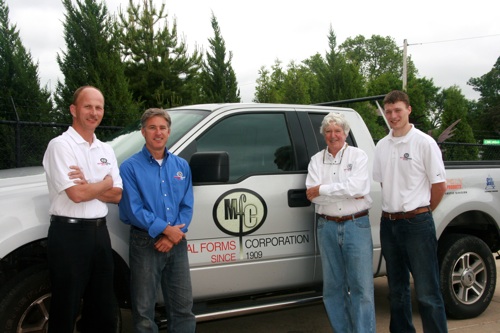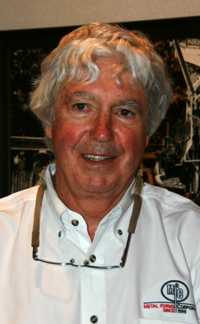A Sterling Story
Sterling Wheelbarrows are reborn, revitalized for a new century of service.
 We could just tell you this story by focusing on the raw news; Metal Forms Corporation of Milwaukee has purchased the Sterling brand of premium wheelbarrows. But presenting just the facts would deprive you of a heck of a back-story. It has everything; a wedding, eccentric inventors and a toy concrete mixer.
We could just tell you this story by focusing on the raw news; Metal Forms Corporation of Milwaukee has purchased the Sterling brand of premium wheelbarrows. But presenting just the facts would deprive you of a heck of a back-story. It has everything; a wedding, eccentric inventors and a toy concrete mixer.
Metal Forms Corporation was born as Reichert Manufacturing in 1909 in the same building it occupies today on Booth Street. Reichert’s original products were straight and curved forms for concrete walls, tanks and silos. Reichert also made forms for a new housing concept of the day, concrete homes. From 1910 to 1913, Reichert’s forms helped build hundreds of “Edison Homes” for employees of U.S. Steel. Inspired by inventor Thomas Edison’s love of concrete, “Edison Homes” presaged today’s concrete home trend by nearly a century.
In 1919 the company changed its name to Metal Forms Corporation and began developing forms for concrete roadways. George H. Miller, who worked for MFC and who would eventually buy it, was also related — by marriage — to another pioneering Milwaukee concrete company. His wife was the sister of Philip and William Koehring, who would build their Koehring Machine Company into one of the largest construction equipment makers in the world.
 An inventor himself, Philip Koehring designed a steam-powered machine that could mix and dispense concrete, an innovation that would revolutionize road building in America. Koehring mixers were large contraptions that created an attending need for sturdy “rails” to support the heavy concrete finishing machinery used on the roadbeds. Brother-in-law George Miller and Metal Forms Corporation were the perfect choice to make them.
An inventor himself, Philip Koehring designed a steam-powered machine that could mix and dispense concrete, an innovation that would revolutionize road building in America. Koehring mixers were large contraptions that created an attending need for sturdy “rails” to support the heavy concrete finishing machinery used on the roadbeds. Brother-in-law George Miller and Metal Forms Corporation were the perfect choice to make them.
Building on the Past
Today, a 1930s’ Buddy-L toy version of a steam-powered Koehring mixer adorns the office of Tom Miller, George Miller’s grandson. Tom bought MFC from his father in 1981 and has a deep appreciation of the company’s history and role in building and paving America. In fact, he has written a book about it, Forming the Roadway to Success: The History of Metal Forms Corporation. Published in 2009 for MFC’s 100th anniversary, the book includes the tale of the Edison Homes and the fact that through the deepest trench of the Great Depression, Metal Forms actually grew a combined 50 percent in 1930 and 1931.
Miller’s appreciation of that history also influenced MFC’s most recent acquisition, the 2008 purchase of Sterling Wheelbarrows. Made in Milwaukee since 1905, and widely considered the world’s best wheelbarrow, Miller says a Sterling is heavier, sturdier and carries more material than any competing wheelbarrow on the market. It also costs more. Well aware of the product’s “sterling” reputation for durability, Miller courted Sterling’s owner for years to let MFC acquire the company, but it took another great depression, this one in 2008, to do it.
 Built Tough
Built Tough
“We finally bought Sterling in late 2008. In 2009 we moved the whole operation from their 20,000-square-foot facility over in Glendale, Wisconsin into a roughly 2,000-square feet area in our facility here,” Miller explains. “The main reason we bought Sterling was for its wheelbarrows.”
MFC quickly set about the complex process of not just relocating and streamlining Sterling’s production processes, but also updating and improving the product as well.
In Miller’s view, the “new” Sterling wheelbarrow from MFC combines the best of both worlds; the innovative features of the original product, plus several key improvements that make it even more durable than before.
“The main feature that differentiates Sterling from competitors is its undercarriage, so to emphasize that we created the slogan, ‘Built tough from the bottom up,’ ” Miller says. “Sterling is the only wheelbarrow that has a welded frame underneath. Every other wheelbarrow on the market uses a bolted system.”
Another key point of difference is that this welded frame is “key seated” to its beechwood handles for a tighter, more secure attachment. The tub is double-lapped and made of the heaviest-gauged steel used on wheelbarrows today. Finally, Sterling wheelbarrow tubs can carry seven cubic feet of material; most competing products haul six.
Making the Best Better
Since acquiring Sterling, some of MFC’s improvements include powder-coating all the metal parts including the tubs, which are now made with a plasma cutter instead of being stamped out. MFC also rounded off the corners of the tub overlaps to make them more visually appealing and friendlier to bare hands. The fortifying rod around the top of the tub’s rim is now made of 3/8-inch thick steel, which Miller contends is the heaviest steel in use on the market.

Tom Miller credits MFC controller Tim Fox, vice president of sales Dan Block and vice president of operations Brian Pfannes for executing the complex integration of Sterling wheelbarrows into MFC’s operations. He singles out Pfannes for spearheading much of the relocation and process improvements.
“Since we’ve purchased Sterling we have applied a wide variety of quality control improvements to the product and its production,” Phannes says. “We have gone though every component and you can really see the improved consistency and quality in each part now. We have a local supplier who does all our powder coating for us. We had pallets made that accommodate the five-foot-long handles, so the handles are no longer prone to damage during shipping. We have kitted and labeled all the assembly hardware, so assembling the products is much easier for distributors and contractors now.”
Tim Fox is clearly pleased with the results. “We have combined these new features and quality control improvements with the features that already made Sterling the toughest wheelbarrow on the market to really make it the true wheelbarrow of choice for concrete and masonry contractors — guys who will use it every day,” Fox says.
 |
| “Distributors are always asking, ‘How can we distinguish ourselves from the competition?’ Well, you make yourselves different by selling products that everyone else doesn’t or can’t sell. Sterling fits that category." — Tom Miller, Metal Forms Corporation |
Spreading the Word
Once they were satisfied with the “new and improved” Sterling, Miller and his team faced a challenge that was in some ways tougher than the wheelbarrow itself — how to get the word out to the market, renew relationships with Sterling distributors and sell to new ones.
“Before we bought Sterling, the previous owner loaded up his distributors with wheelbarrows,” Miller says. “Then the economy tanked and they were all sitting on inventory, so for a while there, dealers had no reason to call Sterling. Between those two factors there was something of a disconnect between Metal Forms and the people who sold Sterling.”
“At first, we went to our Metal Forms dealers and tried to build the wheelbarrows into their form and screed business with us, but that approach was not effective. If they did sell wheelbarrows, they already had their contacts and sources, and we didn’t really tell them why they should buy Sterling other than the fact that we own it now.”
Miller and his team needed a different approach. The result is a steel-clad program from start to finish. MFC developed a metal-covered presentation book that illustrates not only the features and benefits of Sterling wheelbarrows, but also a complete marketing, merchandising, point-of-purchase and pricing structure for distributors — all literally clad in steel. Sterling’s updated “Tough Guy” in-store POP display is also made of solid powder-coated steel and is built right along side the wheelbarrows themselves.
“Distributors are always asking, ‘How can we distinguish ourselves from the competition?’ ” Miller says. “Well, you make yourselves different by selling products that everyone else doesn’t or can’t sell. Sterling fits that category. We don’t sell to the big boxes or the big chains. Why cheapen the product when you have the best?” And, he adds, why sell “volume” when you can make more profit selling a premium product.
MFC is also promoting Sterling with traditional media and online. Helped in part by a tentatively recovering economy, the fledgling campaign is beginning to pay off.
 |
| “Our dealers are starting to see improvement in the market.” — Dan Block, Metal Forms Corporation |
“Our dealers are starting to see improvement in the market,” Block says. “A couple of years ago, contractors were just trying to get by, to buy cheap — whatever they could just to get through a job. But we are seeing them beginning to invest in better products again. Today they are looking ahead and saying, ‘OK, now I need a premium wheelbarrow,’ instead of just saying, ‘I need a product that will get me by today.’ ”
Ready and Rolling
“We’re ready to go,” Miller states. “We’ve made some excellent improvements to an already great wheelbarrow and we are excited to be bringing the Sterling brand back to the marketplace.”
With a combined 200-plus years between them, Metal Forms Corporation and Sterling wheelbarrows aren’t just storied players in the history of concrete construction in the United States, they are determined to be part of its future as well. For those who appreciate the solid heft of history in their hands and no-compromises “Made in the USA” craftsmanship, it’s a story well worth the telling. CS
To learn more, call Metal Forms Corporation at 414-964-4550 or visit the Web site at www.metalforms.com.















